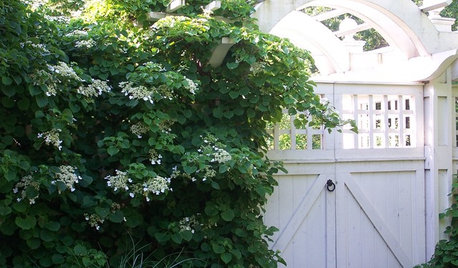RRD Resistant Rose Species
oath5
12 years ago
Featured Answer
Sort by:Oldest
Comments (24)
phoebe
12 years agolast modified: 9 years agoanntn6b
12 years agolast modified: 9 years agoRelated Discussions
Are non-remontants more RRD resistant?
Comments (9)Ann, I have had several of my once blooming ramblers come down with RRD along with a few remontant types. Of course I think New Dawn is a sentinal plant for RRD. However, my ramblers have have taken the largest hit like Mrs. Keays Snow Bush, Mrs. F.W. Flight, Francois Juranville, Alexander Girault, Kew Rambler, American Pillar, a striped setigera (once blooming) from Roy Sheppard, Carmenetta ( a Hy glauca), IXL (a lavender multiflora understock), R. X coryana, Zitkala (a once blooming Hy blanda) Snow Dwarf (a once blooming dwarf wichuriana ground cover), Merveille de la Brie ( a semi double American Pillar), Easlea's Golden Rambler, and Walsh's America. I have had only a few repeat bloomers get RRD. They include William R. Smith, Daybreak and Clytemestra. As you can see the vast majority of my RRD has come to my big plants and mostly once blooming ramblers. Please note that I have about 100 - 200 acres of RRD infected multiflora within a mile of my house and I am on a hill where the winds can blow up and over. Amazingly, my 40' X 30' Bobby James had not come down with RRD, but it may be that I couldn't see it at the top of that mass. However, 30" of snow has crushed it down to 8' this spring. Let's see what I have when it grows back this spring. Best, Nick...See MoreWhat are my options if RRD destroys all my roses?
Comments (9)I wish I could give the person who came up with the bright idea of using RRD as a multiflora control method a good screaming at. It makes as much sense as cutting the rodent population by giving them the plague. I'll put in a plug for Rosa carolina, which last I heard, was still not getting RRD, and is an attractive and fragrant rose, and some strains have a litt;le rebloom. Likewise for R. californica and Burnet roses. Rosa palustris and setigera should be safe picks, though strictly once-bloomers. Aside from switching to wild American roses such as those, there's not much you can do, unless your can talk all of your neighbors into adopting a sane multiflora control method (e.g., bulldozer). Virtually all garden roses, no matter how disease resistant they may be otherwise, are vulnerable, whether they're OGRs or moderns, as are Eurasian wild roses and even many American wild roses. I suppose you could try Baltimore Belle, Souvenir de Brod, Commander Gillette or Bonica, since the latter has shown at least *some* resistance, and the others are hybrids of resistant species. This post was edited by ffff on Sun, Nov 2, 14 at 15:28...See MoreNotes on RRD Resistance
Comments (4)catsrose, not Sappho. I'm really sorry. I had eight new cases of RRD this year, all in my rose field which has a line of very tall, dense cedars to the south. All of these but one of these have been removed, so I can't speak to the speed with which death would have come to them in a more natural fashion. The varieties affected showed no pattern among the classes ... Zephirine Drouhin - Bourbon Daybreak - Hybrid Musk Alba Meideland - Shrub/Climber Marie Nabonnand - HT Climber America - the Walsh Rambler, not the climber Climbing Pinkie Puerto Rico - Tea/ HT Violet Hood - Lens Hybrid Musk None of these roses was directly next to any of the other infected roses, though they did share a similar vicinity within the garden. It was a sad day, standing out there with my pruners and loppers cutting all of these roses into pieces and filling two large rolling trash cans. America is the only rose left to remove, and it will be a huge job....See MoreRRD on drift roses?
Comments (9)That puckering leaf pattern is early stages of Powdery Mildew. Not always does it progress to the full blown baby powder dusting so often seen, especially among newer varieties of roses bred for disease resistance as the Drifts are. Cool nights with hot daytime temps, accompanied with dry conditions, either low/no rainfall or low humidity favor PM outbreaks. It occurs in Pittsburgh, PA mostly in the fall or spring when weather conditions are more favorable for it, and less so during the summertime here, when Black Spot is forefront. Also, not all the Drift varieties have the same level of disease resistance. My Sweet Drift is a Powdery Mildewer, and my Apricot Drft is a Black Spotter, but neither is extremely susceptible, just moderately so. Moses...See Morehenry_kuska
12 years agolast modified: 9 years agooath5
12 years agolast modified: 9 years agoTessiess, SoCal Inland, 9b, 1272' elev
11 years agolast modified: 9 years agozeffyrose
11 years agolast modified: 9 years agocatsrose
11 years agolast modified: 9 years agoTerry Crawford
11 years agolast modified: 9 years agomichaelg
11 years agolast modified: 9 years agohenry_kuska
11 years agolast modified: 9 years agooath5
11 years agolast modified: 9 years agoanntn6b
11 years agolast modified: 9 years agoTennclay
11 years agolast modified: 9 years agoTessiess, SoCal Inland, 9b, 1272' elev
11 years agolast modified: 9 years agobelmont8
11 years agolast modified: 9 years agooath5
11 years agolast modified: 9 years agoffff
9 years agolast modified: 9 years agohenry_kuska
9 years agolast modified: 9 years agoKippy
9 years agolast modified: 9 years agoffff
9 years agolast modified: 9 years agohenry_kuska
9 years agolast modified: 9 years agoffff
9 years agolast modified: 9 years agohenry_kuska
9 years agolast modified: 9 years ago
Related Stories

FALL GARDENING6 Deer-Resistant Flowering Vines to Plant This Fall
Have a major deer problem? Here are some of the only vines that have a chance of not being eaten
Full Story
FALL GARDENING9 Deer-Resistant Flowering Shrubs to Plant This Fall
These exquisite shrubs will attract your attention but won’t tempt the deer that roam your neighborhood at night
Full Story
GARDENING GUIDES8 Deer-Resistant Elegant Evergreen Shrubs to Plant This Fall
Who knew that such beautiful shrubs could be deer-resistant?
Full Story
GARDENING GUIDESTop 12 Summer-Blooming Perennials for Deer-Resistant Drama
Can you have garden color, fragrance and exciting foliage with hungry deer afoot? These beauties say yes
Full Story
CONTAINER GARDENS7 Deer-Resistant Flowers for Your Summer Containers
Grow these as protection for edibles or just for their colorful beauty — deer might not like them, but everyone else will
Full Story
GARDENING GUIDESWhat Kind of Roses Should You Grow?
Want to add the beauty of roses to your garden? Find out which ones, from old-fashioned to modern, are right for you
Full Story
GARDENING GUIDESGreat Design Plant: Rosa Banksiae a Low-Maintenance Beauty
This thornless, disease- and insect-resistant rose brings showers of white or yellow flowers to the spring garden
Full Story
GARDENING GUIDESGreat Design Plant: Knock Out Roses
As glorious as their high-maintenance kin for a fraction of the work, Knock Out roses make even beginners look like garden stars
Full Story
GARDENING GUIDES6 Wonderfully Easy Roses for Any Gardener
Look like an expert even if you're just starting out, with these low-maintenance gems of the rose world
Full Story
WINTER GARDENINGPruning Secrets for Exquisite Roses
Encourage gorgeous blooms year after year with this time-tested advice on how to prune your rosebush in winter for health and shape
Full Story





mike_rivers